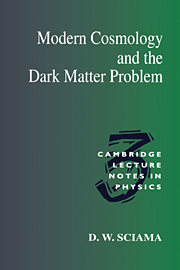Book contents
- Frontmatter
- Contents
- Preface
- Recent Developments
- Part One Dark Matter in Astronomy and Cosmology
- 1 Dark Matter in Galaxies
- 2 Dark Matter in Clusters of Galaxies
- 3 Dark Matter in Intergalactic Space
- 4 The Identity of the Dark Matter
- Part Two Ionisation Problems in Astronomy and Cosmology
- Part Three Neutrino Decay and Ionisation in the Universe
- Part Four Observational Searches for the Neutrino Decay Line
- References
- Subject index
1 - Dark Matter in Galaxies
Published online by Cambridge University Press: 11 January 2010
- Frontmatter
- Contents
- Preface
- Recent Developments
- Part One Dark Matter in Astronomy and Cosmology
- 1 Dark Matter in Galaxies
- 2 Dark Matter in Clusters of Galaxies
- 3 Dark Matter in Intergalactic Space
- 4 The Identity of the Dark Matter
- Part Two Ionisation Problems in Astronomy and Cosmology
- Part Three Neutrino Decay and Ionisation in the Universe
- Part Four Observational Searches for the Neutrino Decay Line
- References
- Subject index
Summary
Introduction
The detection of dark matter in astronomy has a long history. In past years it was called “the astronomy of the invisible”. The story begins in 1844 when, by chance, two different dark matter problems were identified. In that year it was noted that the planet Uranus had moved away from its calculated position by as much as two minutes of arc. In the same year F. W. Bessell drew attention to the sinuous motion of the star Sirius, the brightest star in the sky.
The subsequent development of the Uranus problem led to one of the most famous stories in the history of astronomy. In 1845 J. C. Adams, who had just ceased to be an undergraduate at Cambridge University, succeeded in calculating fairly accurately the position of a hypothetical planet whose gravitational effect on Uranus might be responsible for its disturbed motion. He attempted unsuccessfully to interest the Astronomer Royal G. B. Airy in this prediction. Apparently Airy had attributed the discrepancy to a departure from Newton's law of gravity. Perhaps also he was unimpressed by the student's youth.
Independently of Adams, in 1846 the Frenchman Le Verrier calculated the position of the hypothetical planet with a precision of 1 degree. (For a much shortened version of the needed calculations see Lyttleton 1958). Le Verrier contacted a German astronomer, Galle, at the Berlin Observatory, who rapidly succeeded in observing a new planet (Neptune) within 1 degree of the predicted position. The discovery of this planet (no longer “dark”) is widely considered to be a triumph of nineteenth century science, and naturally became the subject of chauvinistic controversy.
- Type
- Chapter
- Information
- Modern Cosmology and the Dark Matter Problem , pp. 1 - 8Publisher: Cambridge University PressPrint publication year: 1994

